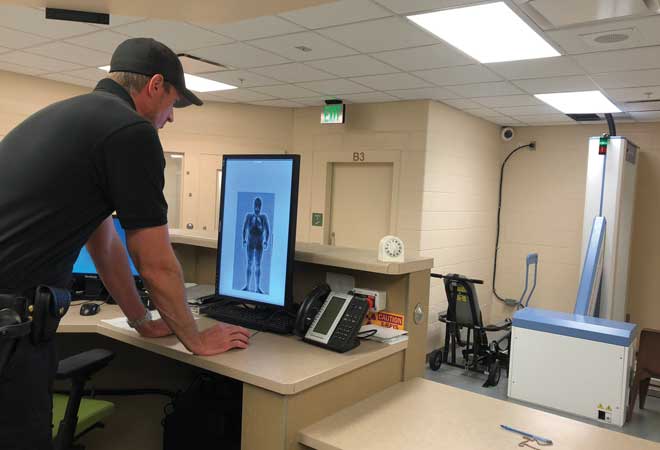Increase in inmate aggression and substance-related arrests
By Cayla Vidmar
On August 14 the Board of Gunnison County Commissioners toured the Gunnison Detention Center, which was built in 2011. The new building was a much-needed upgrade from the old jail, which was previously in the county court building on East Virginia Street.
Although the new building has been a blessing, there are still unique struggles faced by rural detention centers, increases in inmate aggression, and substance-related arrests that the staff at the detention center are facing.
“There is no question that this [new] facility is an amazing upgrade and it is greatly appreciated by both the staff and the inmates,” explained captain Clayton Curtis via email following the tour. However, it’s clear that even with a new facility, the detention center staff still has their work cut out for them.
“As our community grows and our culture changes, becoming more aggressive, violent and unpredictable, we need more staff and resources.” Curtis explains. “The old jail was overpopulated for a significant amount of time, and was very unsafe for everyone involved. It had a max capacity of 28 and often housed 40.”
The new detention center can house more than 40 inmates comfortably when it is fully staffed, and can hold inmates up to two years. The new building includes a media room in which inmates can attend church or substance abuse services or attend specific court proceedings via video communication. There is also an indoor basketball court and a library overflowing with books.
However, the staff still experience issues that are unique to smaller jails in rural communities, including providing mental health services for inmates due to staffing irregularity at the Center for Mental Health in Gunnison. “The center has had a difficult time staffing, ultimately causing the difficulty in the services provided,” said Curtis. “We will have a period of time with a high need for the services and then that need drops for months before picking back up. We are seeing an increased need for mental health [services] with the increase in drug use in the valley.”
Kimberly Behounek, Center for Mental Health Gunnison and Hinsdale counties regional director, stated “we’ve got to pay people and there’s the same kind of ebb and flow with staffing and need patterns at the center, but just like any business in the valley, you have to have a need and match that with staffing.”
This has forced Curtis and his staff to become “professional minimalists,” as he says, because “We cannot and would not ever deny mental health if an inmate requests it,” regardless of staffing issues at the jail or the Center for Mental Health. This need led to grant funding that allows a staff member from the Center for Mental Health to go to the jail once per week to see incarcerated clients.
During the tour Curtis described a rise in a particularly disgusting form of retaliation inmates have been using within holding, the area new inmates stay prior to getting booked. Inmates spread their feces, urine and other bodily fluids over themselves and their holding cells, the thought being it makes the officers’ jobs more difficult. In one case, Curtis described two inmates competing with each other on who could be more revolting. “It becomes a bit of a mind game because we are thinking of the potential diseases that they are trying to spread, so we have to take all necessary precautions when dealing with the situation,” he says.
Curtis has noticed a shift in inmate aggression, and says, “Drugs and alcohol are a big reason inmates are more aggressive. They are also in a position where they have very little control and that will make anyone uncomfortable.”
The Center for Mental Health in Gunnison has seen a decline in the number of individuals who come into the center for substance abuse treatment. According to Katelyn Vogt, the communications and public relations coordinator for the Center for Mental Health, in 2016, 903 clients were seen for substance abuse; in 2017, that number dropped to 857. So far in 2018, 746 people have sought treatment for substance abuse. These figures represent only those seeking treatment for substance abuse, and do not represent the Gunnison Valley population.
Behounek commented on the substance abuse in the valley, noting “there’s still a lot of stigma in this valley about seeking help, needing help, receiving help. Being in a small rural community, if you walk in a building labeled mental health, you get worried about what people think, the fear of stigma is real in this valley.” She also noted that people seeking treatment for mental health disorders might be self-medicating with substances but not seeking help with substance abuse. So while numbers of individuals treated for substance abuse has gone down, there’s much more at play valley wide that might not be represented in those numbers.
Curtis says from his own observation as a native of Gunnison, “There is a significant increase in drug use and subsequent arrests. It is becoming rarer to have an inmate come in who has not smoked marijuana within the last 24 hours.”
He explains, as a kid in Gunnison, he wasn’t even aware there was a jail in town, and has found “Many people in our community still don’t know that there is a jail.” Of those who know of the jail, Curtis finds they tend to think there is only the occasional DUI or assault arrest. “This is not the town of Mayberry in Hendricks County,” as in TV’s Andy Griffith Show, he says. “We deal with some people who have made some bad choices.”
Staffing within the jail can also be struggle, as the job is incredibly difficult mentally and physically, and “Most people in the last few years have moved on to something different,” says Curtis. He explains, “For longer-term employees, their job has shifted to constantly training new hires and picking up the missing pieces.”
He says, “With the new building it did not change what we are responsible for; it just gave us the opportunity to be responsible for more with the same amount of staff.”
These difficulties have forced staff to “learn how to perform under extreme stress for long periods of time while doing the job of what at least five to seven people do at other facilities,” says Curtis. He’s been told by his peer group that in order to run the jail safely and effectively, he’d need to double the facility’s full-time staff.
Despite the inherent difficulty of the job, Curtis seems determined to work through struggles and continue to create a well-functioning work place and detention experience. “My job and my goal is to look at what we have been given by our community, look at the changing times, crimes, inmates, behaviors and develop a plan to run this facility safely, effectively and efficiently. Seemingly every day a new challenge or problem arises and we get to figure out the best possible solution with what we’ve been given,” he concludes.
 The Crested Butte News Serving the Gunnison Valley since 1999
The Crested Butte News Serving the Gunnison Valley since 1999


